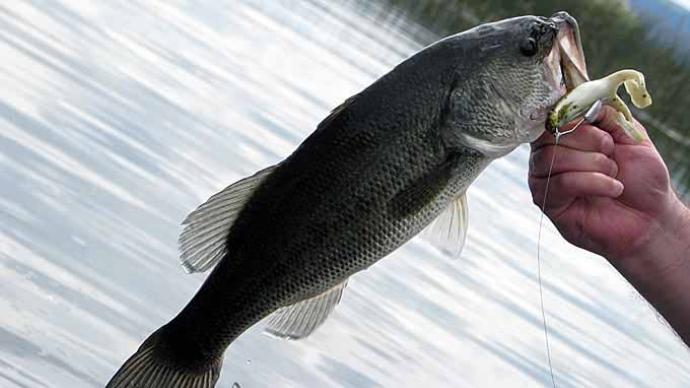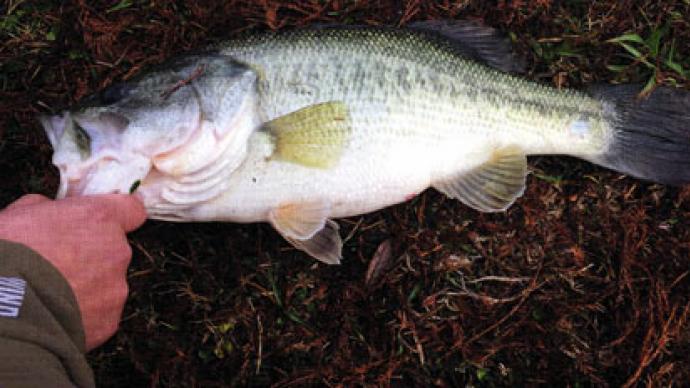
Angling is the art of catching fish, whether fishing for saltwater or freshwater species. It involves enticing a fish into biting or striking your bait or lure. Most people go fishing with a rod, a reel, line, a hook, a sinker, and bait or a lure. People fish for sport, for food, or both.
Fishing started back about 2000 B.C. when Egyptians used a rod and line or a net. The Chinese back at that time used lines made from silk, a hook made out of a needle, a bamboo rod, and cooked rice for bait. The Greeks, Assyrians, and others fished in ancient times also.
Fishing tackle has taken significant "jumps" from the old style to a new style. Rods have remained short for a long time. They were usually only a few feet in ancient times, but these days some rods are fifty feet long which are used in Europe for fishing "matches" or tournaments. Ancient rods were usually made of bamboo. Rods before the eighteenth century were sometimes made of lacewood or greenheart. In the nineteenth century, new techniques for bamboo rods, like strips glued together or hexagonal, were made. It wasn't until the twentieth century that fiberglass and graphite rods were made.
Fishing reels have also made much advancement over the years. The first primary reel had a wooden spool with a metal ring attached that the fisherman put his finger through. Then reels with multiplying gears came on the scene, which became the prototype of baitcasting reels in the 1800s. In 1896 William Shakespeare made a reel with a level wind that evenly spun line onto the reel. There are baitcasters with digital cast control systems and spinning reels with sixteen bearings. These are just a couple of the advancements of reels.
The lure is one of the essential tools in fishing and has made many changes in how we fish. There are six basic lures: spinner-type lures, plugs, jigs, soft plastics, spoons, and flies.
Spinner-type lures have a shaft, split rings, a hook, a blade, a clevis, and a weight. They work in both clear and dirty water. The flash from the blade is the most attractive part, catching bluegills to muskies.
There are four kinds of spinner-type lures: standard spinners, weight-forward spinners, spinnerbaits, and buzz baits. A standard spinner will catch almost all types of game fish and ranges in size from one inch to about eight inches. A weight-forward spinner is mostly for trolling or drifting for smallmouths, walleyes, and pike. A spinnerbait, used for bass, pike, and muskies, has a bent shaft and one- to four blades. A buzzbait looks like a spinnerbait, but it is reeled on the surface while the blade spins and makes noise and commotion on the top of the water. It catches the same species as a spinnerbait will.
Plugs are usually made to look like baitfish, but others look like bugs, crayfish, and frogs. There are nine different types: stickbaits, prop baits, crawlers, chuggers, crankbaits, minnow plugs, vibrating crankbaits, trolling plugs, and jerkbaits. These lures can be used for all species of gamefish under most conditions and come in a wide variety of shapes and colors. Stickbaits, prop baits, crawlers, and chuggers are topwater baits primarily used for bass. Jerkbaits are sometimes larger and used for pike and muskies. They dive and then rise back to the surface when given a swift jerk. A minnow bait is usually a plastic stick or balsa shaped like a minnow. Some contain rattles, and some suspend in the water column when stopped.
Crankbaits are probably the most popular and versatile lures on the market and catch many fish species. However, most people consider them a bass lure. They range in size from one inch to about twelve inches. Vibrating crankbaits consist of a shad-shaped chamber and several rattles, attracting most gamefish. Trolling plugs are used for trolling in a boat and usually have a prominent, flattened forehead that gives the lure a wide wobble. They are usually not cast because they are too light. They work for many species, from walleye to muskies.
When most people think of jigs, they think of a jighead with soft plastic, live bait, or hair. However, there are three other different types of jigs: jigging spoons, vibrating blades, and tailspins. The standard jig, which is a jighead with a trailer, is effective when the fish are in a neutral or negative feeding mood because it can be fished slowly. They are also effective for active if you swim the standard jig with live bait or plastics. Jigging spoons are mainly used when ice fishing for pike, walleye, and panfish, usually tipped with a minnow. Vibrating blades can be trolled or cast and consist of a metal blade with a chamber that holds rattles, much like a rattling plug. They work for most predator species and can be used with many techniques. The blade has a tight wiggle that shakes the rattles. Tailspins consist of a blade, a hook, and the body's weight. They can be reeled at a steady pace or jigged while the blade spins on the shaft. Most people use them for bass and panfish.
Soft plastics are from the 1860s, but they weren't as lifelike as today's soft plastics when they first came out. Today, there are many different kinds, shapes, and colors of soft plastics. Some of the favorites are worms (the first to come out on the market), lizards, tubes, flukes, craws, grubs, swim baits, paddle tails, etc. Soft plastics are banned in some parts of the world because they aren't biodegradable, but now, that problem is being solved with the new biodegradable baits. Many soft plastics are impregnated with scent and have salts to allow the fish to hold on to the bait for a more extended period. If you're fishing in weeds, either a Carolina rig or a Texas rig would be best. If you're fishing rocks or weed edges, I will use a jig head, live bait, or Aberdeen hook with split shots six to ten inches above the hook if the fish are finicky.
Spoons, which wobble or flutter, mimic injured or crippled baitfish and are used for bass, pike, muskies, trout, and salmon. Most of them are either standard or trolling spoons, but there are also weedless spoons used for bass in weeds or slop. Trolling spoons are lighter and thinner than standard casting spoons, making them hard to cast. Trolling spoons need a weight or a diving board to fish with because they would flutter back to the top of the water. Most people use downriggers or dipsy divers. Some spoons have treble hooks, and others have single hooks. The reason for single hooks is that they are less damaging to the fish's mouth.
Flies are one of the oldest lures, consisting of a hook, hair, and sometimes beads or wire. Flies seem pretty straightforward, but they're harder to make than it looks. Most people use a fly rod, but you can also use spinning equipment with a casting bubble. Casting with a fly rod is also harder than it looks. Fly fishing is harder to learn, but some find it more rewarding "doing it the old way," and some find it more of a challenge or enjoyment. I am not a fly fisherman, so I know more about spinning and baitcasting techniques.
Your reel is a critical component of fishing because you wouldn't be able to retrieve or put much action or cadence to your lure without it. There are four different types of reels: spinning, baitcasting, spin-cast, and fly reels. Spinning reels, also called open face reels, are probably the most popular and versatile of all reels, mainly used for finesse situations or panfish. The bigger sizes are used for bigger species or saltwater but are rarely used for trolling. A lighter line is usually used on spinning reels because a heavier line would coil off like a spring, sometimes making a mess. While you spin the handle on a spinning reel, the rotor spins while a gear pushes the spool up and down to wind the line on evenly.
Baitcast reels fall into three categories: Round, low profile, and trolling reels. Round reels are the standard of baitcasting reels and usually hold a lot of line. They are used mainly for bass, pike, and muskies but smaller for crappie fishing. Low-profile baitcasting reels are easier to palm but sometimes don't hold as much line. They are mainly used for bass fishing. For reducing the number of backlashes, or "professional overrun," most baitcasters have a cast control and either magnetic, centrifugal, or digital cast controls.
Trolling reels are usually bigger and harder to palm. They are mainly used to catch bigger species but can fish for everything from walleyes with small crankbaits to giant marlin with cut bait. Most of these have a clicker, a level wind, and a simple anti-backlash mechanism.
Spincast reels also called push button reels, are usually easier to use. They are like a spinning reel, except the face is closed, and the spool is not pushed up and down, so the line is not spooled as evenly on. These reels usually have sticky drags that aren't as good as spinning or baitcasting reels, so I wouldn't recommend fishing for large fish with these reels.
Fly reels are the simplest made because they are usually used only to hold the line, except for the few times a big fish pulls line from the reel. Most have multiplying gears, but some are single action, meaning that with each turn of the handle, the spool rotates several times.
Fishing rods come in different types, one for every situation you face in fishing. Different rods are usually determined in power, action, length, and pieces.
Power is basically how "beefy" the rod is. Action is how the bend fluctuates in the rod. For example, a slow action rod has a more even bend up the whole rod, and fast action has a tip that bends faster than the rest. Many anglers get these two mixed up.
Length is a critical consideration when buying a rod. You should ask yourself some questions when determining the length of your rod. Do you need to cast far, or do you need to keep the line off the water as much as possible? Well, then I would buy a long rod. But what if the area you fish is confined and is littered with brush and trees? Then I would opt for a short rod. What if you need to travel, or do you want a handy "car rod"? Then you will want to get a rod that comes in connectable pieces. Most pieced rods are two pieces, but some can even be eight pieces.
But you can't forget the categories of rods! Typically there are spinning, baitcasting, and fly fishing rods. Spinning rods are, of course, for spinning reels and baitcasting rods are for baitcasting reels. The differences are that spinning rods have bigger guides that run along the underside of the blank, and baitcasting rods have guides that run along the top. Each has unique reel seats too.
There are many more things that I could cover on the art of angling, but it would almost be too much to mention everything there is to it. But hopefully, you get the idea of what fishing is all about, and maybe you picked up a few tips.




